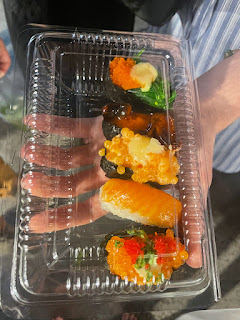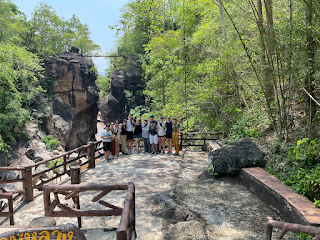**updated 5/20 4pm** As it turns out, we are actually "on grid" at the Hotel Sarisa, so I'll be able to post updates every few days, and I'm editing this post to add more info and photos.
Night of 5/18–the students and I had dinner at Tong Tem Toh, my favorite restaurant of the trip that features northern Thai cuisine (Burmese influence) before visiting the night bazaar. From what I can gather, Burmese curry has a different flavor profile A quick consultation of the internet oracle indicates that a traditional Burmese curry will feature some or all of the following: turmeric, ginger, garlic, chilli, and lemongrass--I'm also seeing fish sauce in a few recipes.
5/19 was a free day for everyone, but we gave folks lots of options that they could choose from. One student went horseback riding, while another group (myself included) did what might have been my favorite experience of either trip I’ve taken to Thailand: a cooking class!
We met our chef/teacher, Perm, at a small, local Thai market. He walked us around the market, explaining various types of produce and herbs, and explained how to check various fruits and vegetables for freshness. We also bought the ingredients that we would need for our menu.
We left the market and traveled about 20 minutes out of town to the site for our cooking lesson. It was a beautiful, open air kitchen with individual cooking stations, overlooking a garden and rice field.
Perm taught us how to make:
- Tom Yum Kung - a common and popular Thai soup served with many meals. Features Thai chilis, mushrooms, chicken and/or prawns, and other herbs and vegetables.
- Pad Thai
- Stir-fried Chicken with Cashew Nuts
- Panang Curry - this was the standout for me. We made the curry paste from scratch. It was labor intensive but totally worth it!
- Mango Sticky Rice
Such a fantastic experience. If you find yourself in Chiang Mai, I can't recommend highly enough The Best Thai Cooking School. My photos really don't do the experience justice.
We had a few hours of free time in the afternoon before the group left the hotel to visit Wat Chedi Luang for the annual Inthakin festival.
From Thaizer.com
CHIANG MAI CITY PILLAR INTHAKIN FESTIVAL
Many towns and cities in Thailand house what is known as the ‘city pillar’. These pillars were created when a new settlement was established and often located at the geographical heart of the city. The pillars were originally made of wood or stone, but in most cases now have ornate protective metal or brass casings. Different regions of Thailand have different names for these pillars, but in the old northern Thai language the pillars were called ‘Inthakin’. Some historians believe the pillars represent a phallus and were created to encourage the fertility of the land which would have been crucial to an agricultural society. These ancient animist beliefs pre-date the arrival of Buddhism in Thailand, but even as Buddhism spread the old traditional beliefs still remained, just as they do in so many aspects of Thai society today.
THE LEGEND OF CHIANG MAI’S INTHAKIN CITY PILLAR
There is an ancient legend that tells the story of how the original site of Chiang Mai was a town plagued with demons. A hermit asked the god Indra for help and from the heavens came the Inthakin pillar to protect the town and the people from the demons. However, in time the people neglected the pillar and the demons returned and the town was left in ruins. In 1296, King Mengrai chose the site of Chiang Mai to be the new capital of the Lanna kingdom. King Mengrai found the old city pillar amongst the ruins of the town and was told the legend about the demons. He placed the pillar at the geographical centre of the new city in a temple called Wat Sadue Muang. Today, the remains of this temple can be seen in and around the grounds of the Cultural Hall (just behind the Three Kings Monument) in the old town area of Chiang Mai.
It was a unique opportunity to experience local Thai culture at a micro level. There were musical demonstrations, carnival games, and tons of food stands and booths where folks could make religious offerings.
We closed the evening by attending a Muay Thai fight. I have a huge blog post about Muay Thai from last year that I will link here that explains some of the nuances and history of Muay Thai. Three of the seven fights ended in knockouts!
5/20: Op Luang National Park and travel to Omkoi
We left Chiang Mai this morning to travel to Omkoi, a rural village about 3 hours southwest of Chiang Mai. About halfway through the drive, we stopped to hike and have lunch at Op Luang National Park. I also have a really thorough post about Op Luang from last year (link). I'm sorry to repost old content but it seemed silly to duplicate efforts for the same information.
Here are a few key facts:
- Ob Luang - roughly translates to "Large Straight" referring to the Mae Chaem river cutting through the canyon walls
- Ob Luang protected by Thai government in 1966; originally designated as a site for timber harvesting
- Established as an official national park in 1991, making it the 68th national park in Thailand
- Along our hike, we had opportunities to view remnants of a grave from the Bronze Period (3300-1200 BCE) and pictographs (paintings on rock).





















No comments:
Post a Comment